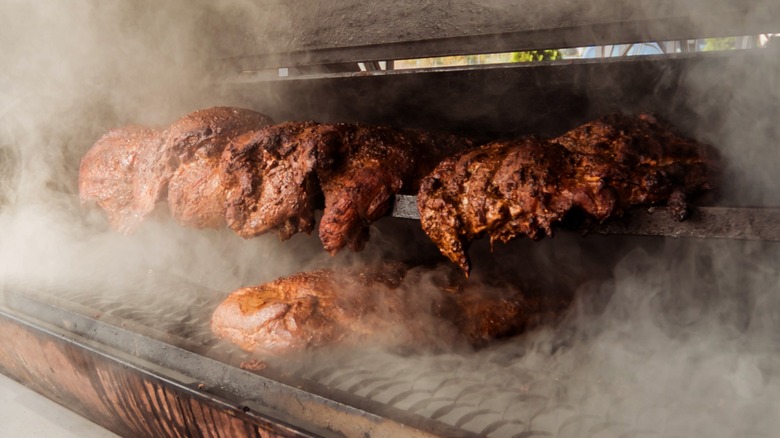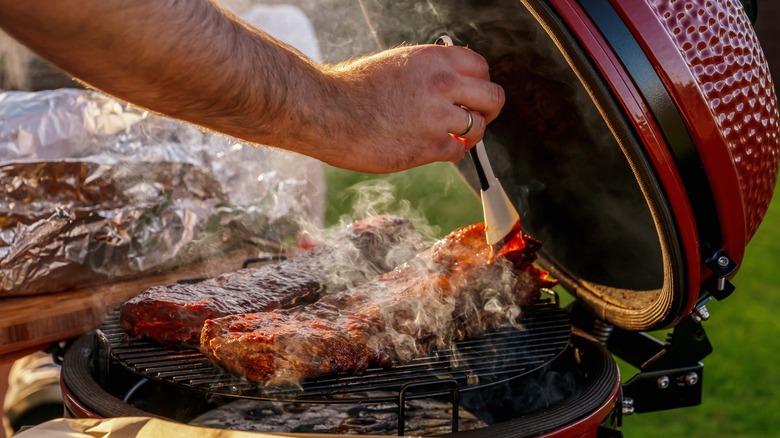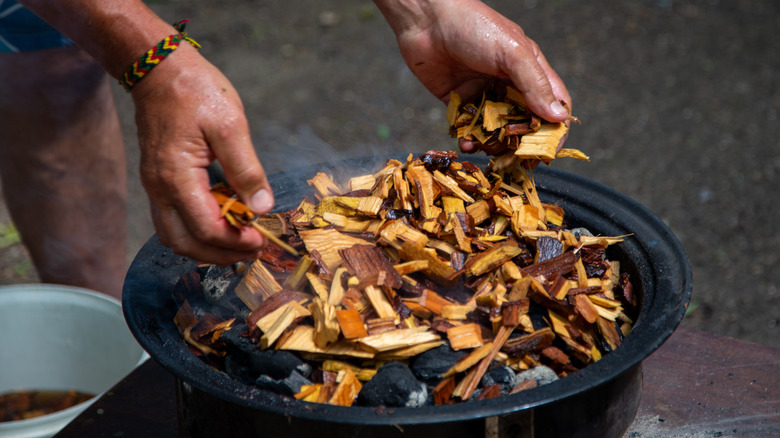Is There A Difference In Smoking Pork Vs Beef? A Grill Master Weighs In
Smoking food is an art to be mastered; just ask anyone who's spent countless hours tending meat in their cherished drum, kettle, egg, electric, or any other style of smoker. For true devotees, it's way more than a pastime or a way to feed the gang. Once you've found your smoking groove, there's no going back. However, there's always something new to learn, which is why we're sharing some insights from smoking expert Adam Truhler of YouTube's The Grilling Dad.
Regarding the difference between smoking beef and pork, Truhler first notes how they have the same three objectives. You want to get delicious smoky bark on the exterior of the cut, render the fat and connective tissue, and end up with tender, juicy meat. Those things are crucial regardless of the type of meat or the cut. That tender juiciness is attainable with both high-fat cuts and tougher cuts, he explains.
Meats with a generous amount of marbling stand up well to the heat and duration of longer smokes, while that "low 'n slow" smoking approach is actually essential for cuts such as beef brisket to become tender. Timing is much the same, as well. "Regardless of whether you are smoking pork or beef, the time required to achieve the three goals is largely dependent upon the size of the piece of meat and the temperature that you cook it at," says Truhler. But differences do arise when considering price, rubs, and wood chips for beef versus pork.
Cuts of beef and pork affect the price of smoking
Cooking on the grill is generally considered similar in cost to indoor oven or stovetop methods. But when you're smoking meats, the equation changes a bit. Certain types of cuts are more ideal for smoking, and they may carry considerably different costs for pork versus beef.
The cuts of pork are almost always cheaper than cuts of beef. For example, according to Adam Truhler, "the most popular cuts of pork for smoking are butts/shoulders, baby back ribs (sometimes called loin back ribs), spare ribs (St. Louis cut spare ribs), and pork belly (think of pork belly as pre-bacon). In our area, we can usually get pork for under $3 per pound and sometimes right around $2 per pound."
On the other hand, the most popular choices for beef, which are brisket and "dino" beef ribs, tend to be considerably pricier. "In our neck of the woods, these are almost always $4+ per pound for Choice grade. Prime grade costs more but often has more marbling, which makes the meat more forgiving (easier to smoke), and more delicious." In that sense, the best cuts of meat for smoking do make a difference. Since beef and pork are both going the "low 'n slow" route for juicy tenderness, it may really come down to budget considerations and personal preferences.
Wood chips and rubs impact flavor differently in beef versus pork
Debates over rubs and wood chips rage in smoker-guru circles, and there's a good reason for that. The type of wood used in your smoker uniquely affects the flavor, and those flavors pair differently with various types of meat. The same goes for rubs. The wood chip and rub pairing choices for beef versus pork are very specific. "Pork tends to work better with sweeter rubs than beef does," Adam Truhler explained, adding, "but can be very delicious smoked with nothing more than salt and pepper."
For the wood chips, choose slightly milder smoking woods such as apple or cherry. They're fruity and subtly sweet, which many professionals consider a compatible flavor for pork: think honey-baked hams. Depending on where you live, availability and cost can vary, with apple wood generally being one of the priciest smoking chips. Beef, on the other hand, tends to work better with more savory rubs and bolder wood chips.
"Beef has a bit stronger flavor than pork, so it can take a more pungent smoke flavor than pork," notes The Grilling Dad expert. "That being said, don't be afraid to experiment and find what you like!" Whether you're grilling or smoking, and whichever meat you're craving, Truhler and his cohorts are happy to be your resource for all things grilling on both their YouTube channel and website. With 16 young-uns between three team members, they know a thing or two about cooking and feeding folks.


